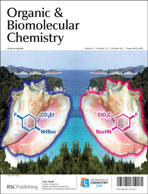Thirteen enantiopure paddlewheel-shaped dirhodium(II) tetrakiscarboxylate complexes have been checked for their efficiency in the dirhodium method (differentiation of enantiomers by NMR spectroscopy); six of them are new. Their diastereomeric dispersion effects were studied and compared via so-called key numbers KN. Adducts of each complex were tested with five different test ligands representing all relevant donor properties from strong (phosphane) to very weak (ether). Only one of them, the dirhodium complex with four axial (S)-N-2,3-naphthalenedicarboxyl-tert-leucinate groups (N23tL), showed results significantly better for all ligands than the conventional complex Rh* [Rh(II)2[(R)-(+)-MTPA]4; MTPA = methoxytrifluoromethylphenylacetate]. On the basis of 1H{1H} NOE spectroscopy and X-ray diffraction, a combination of favourable anisotropic group orientation and conformational flexibility is held responsible for the high efficiency of N23tL in enantiodifferentiation. Both complexes, Rh* and N23tL, are recommended as chiral auxiliaries for the dirhodium experiment.

You have access to this article
 Please wait while we load your content...
Something went wrong. Try again?
Please wait while we load your content...
Something went wrong. Try again?


 Please wait while we load your content...
Please wait while we load your content...